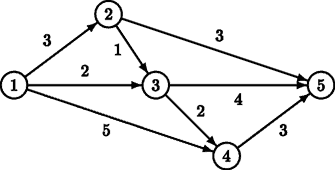【Dijkstra+邻接表求次短路】POJ Sightseeing 3463
|
Language:
Default
Sightseeing
Description Tour operator Your Personal Holiday organises guided bus trips across the Benelux. Every day the bus moves from one city S to another city F. On this way, the tourists in the bus can see the sights Different groups of tourists may have different preferences for the sights they want to see, and thus for the route to be taken from S to F. Therefore, Your Personal Holiday wants to offer its clients There is a restriction on the routes that the tourists may choose from. To leave enough time for the sightseeing at the stops (and to avoid using too much fuel), the bus has to take a short route from S to F.  For example, for the above road map, there are two minimal routes from S = 1 to F = 5: 1 → 2 → 5 and 1 → 3 → 5, both of length 6. There is one route that is one distance unit longer: 1 Now, given a (partial) road map of the Benelux and two cities S and F, tour operator Your Personal Holiday likes to know how many different routes it can offer to its clients, under the above restriction Input The first line of the input file contains a single number: the number of test cases to follow. Each test case has the following format:
Output For every test case in the input file, the output should contain a single number, on a single line: the number of routes of minimal length or one distance unit longer. Test cases are such, that this number is at most 109 = 1,000,000,000. Sample Input 2 Sample Output 3 Hint The first test case above corresponds to the picture in the problem description. Source |
题意:
旅行团从S地出发到达T地。为了省油要求尽量走最短路径或比最短路径长1单位距离的路径。求满足条件的路径条数
解题思路:
相信最短路非常easy求出来的,主要是次短路怎样求出???
我们能够先求出从S到T的次短路的距离。然后推断这个距离与最短距离是否相差为一?所以我们的任务就变成了求解次短路和最短路的问题。
(s。u,v)代表从s——v的最短路,u是中间一个必经点。
我们先看看最短路和次短路的比較:
①(s,u,v)最短路=到达前一个点u的最短路+(u。v)的最短路。
而最短路求解有两种情况:
①(s。u。v)次短路=到达前一个点u的次短路+(u。v)的最短路。
②(s,u,v)次短路=到达前一个点u的最短路+(u,v)的次短路。
所以根据次短路的求解条件。能够在求解最短路的时候求解次短路。
我们用:d[ v ][ 0 ]代表最短路,d[ v ] [ 1 ]代表次短路。
(一)假设从s—u的最短路加上(u,v)权值的距离小于原来的d[ v ][ 0 ] ,我们就可把次短路d[ v ][ 1 ] 的值更新为d[ v ][ 0 ]。就该题而言,此时能够把次短路的条数也更新为这个点的最短路的条数;把当前最短路d[ v ][ 0 ]的值更新成最小的,和原来最短路的松弛操作是一样的。
(二)假设从s—u的最短路加上(u。v)权值的距离大于原来的d[ v ][ 0 ],这就说明这条路路径就可能是一条次短路,那我们须要推断这条路的值dist。和原来的次短路的值d[ v ][1]进行比較!
①假设它比原来的次短路要大,直接跳过。
②假设它比原来的次短路要小,那么我们就须要更新最短路的长度。
③假设与原来的次短路相等。说明我们的次短路有还有一种(这里并不一定是仅仅有1种)方法能够到达终点v。这里要加的种类是:原来到v点的次短路的条数+到u点的次短路(或者最短路。(u。v)并不知道是不是一定是最短路,假设是次短路,那么此时加的就是到u的最短路)的条数。
次短路的情况已经分析出来,最短路的情况是比較easy得出了的。和Dijkstra操作正常的松弛操作就能够了。只是本题让求路径条数。所以要在松弛操作出现相等情况时进行相加操作。这一点比較简单,不在分析,具体看代码。
AC代码:
#include <stdio.h>
#include <math.h>
#include <vector>
#include <queue>
#include <string>
#include <string.h>
#include <stdlib.h>
#include <iostream>
#include <algorithm>
#define INF 0x3f3f3f3f using namespace std; const int MAXN = 10010;
const int MAXM = 100010; struct Edge
{
int from;
int to;
int w;
int next;
}edge[MAXN]; int tot;
int head[MAXM]; void addEdge(int u,int v,int w)
{
edge[tot].from=u;
edge[tot].to=v;
edge[tot].w=w;
edge[tot].next=head[u];
head[u]=tot++;
} int d[MAXM][2];//记录最短路、次短路距离。 int c[MAXN][2];//记录最短路、次短路路径条数。
int vis[MAXN][2];//记录最短路、次短路时该点是否被訪问过。
int N,M; void Dijkstra(int s)
{
int flag;
int k;
for(int i=1;i<=N;i++){
c[i][0]=c[i][1]=0;
d[i][0]=d[i][1]=INF;
vis[i][0]=vis[i][1]=0;
}
d[s][0]=0;
c[s][0]=1;
int min_dist=INF;
while(true){
int v=-1;
for(int i=1;i<=N;i++){ //我们并不能确定取出的最小值的就一定是最短路的点
for(int j=0;j<2;j++){//所以要遍历次短和最短的点。
if(!vis[i][j]&&(v==-1||d[i][j]<d[v][k])){
v=i;
k=j;//记录这个点是次短还是最短
}
}
}
if(v==-1) break;
vis[v][k]=1;
for(int i=head[v];i!=-1;i=edge[i].next){
int j=edge[i].to;
int dist=d[v][k]+edge[i].w;;
if(dist<d[j][0]){//dist小于最短路径长。 d[j][1]=d[j][0];//次短路径长
c[j][1]=c[j][0];//次短路径路径数目
d[j][0]=dist;//最短路径长
c[j][0]=c[v][k];//最短路径路径数目
}
else if(dist==d[j][0]){//dist等于最短路径长:
c[j][0]+=c[v][k];//最短路径路径数目
}
else if(dist<d[j][1]){//dist大于最短路径长且小于次短路径长:
d[j][1]=dist;//次短路径长
c[j][1]=c[v][k];//次短路径路径数目
}
else if(dist==d[j][1]){//dist等于次短路径长:
c[j][1]+=c[v][k];//次短路径路径数目
}
}
}
} int main()
{
int t;
scanf("%d",&t);
while(t--){
tot=0;
memset(head,-1,sizeof(head));
scanf("%d%d",&N,&M);
int u,v,w;
for(int i=0;i<M;i++){
scanf("%d%d%d",&u,&v,&w);
addEdge(u,v,w);
}
int s,g;
scanf("%d%d",&s,&g);
Dijkstra(s);
int res=c[g][0];
if(d[g][1]==d[g][0]+1){
res+=c[g][1];
}
printf("%d\n",res);
}
return 0;
}
最新文章
- 修改windows自带的Ctrl+Space输入法切换快捷键
- SBT的用法
- 在Unity中使用TDD - 初探
- HT For Web 拓扑图背景设置
- 做10年Windows程序员与做10年Linux程序员的区别
- 【leetcode】Isomorphic Strings(easy)
- c#...的类型初始值设定项引发异常。
- PHP 获取网上文件内容
- 异步HTTP请求
- Zephyr-开发流程
- CentOS6 yum源支持更多rpm包的升级(使用第三方软件库EPEL、RPMForge与RPMFusion)
- Writing Science 笔记 6.20
- 织梦dedecsm系统"企业简介"类单栏目模版如何修改和调用
- 如何破解Excel VBA密码
- 中文乱码总结之web乱码情景
- 【Python】【电子邮箱】
- 【Guava 】Collections – Join and Split
- java 异步机制与同步机制的区别
- python安装教程(Windows系统,python3.7为例)
- git 经常使用操作集锦